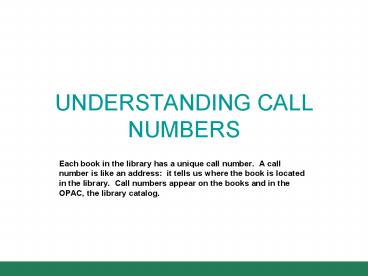UNDERSTANDING CALL NUMBERS - PowerPoint PPT Presentation
1 / 20
Title: UNDERSTANDING CALL NUMBERS
1
UNDERSTANDING CALL NUMBERS
- Each book in the library has a unique call
number. A call number is like an address it
tells us where the book is located in the
library. Call numbers appear on the books and in
the OPAC, the library catalog.
2
Two types of systems are used for call numbers
Library of Congress Classification System
LCC uses a combination
of letters and numbers and
classifies books by subject used by many
academic libraries
3
Did you know that your library has a great way
of organizing its books so that you can find
them easily?
Get to know the DDC
4
Its called the Dewey Decimal Classification
systemor DDC. This system got its name from
Melvil Dewey (1851-1931), who introduced his
great idea for organizing library collections in
1876.
Melvil Dewey
Get to know the DDC
5
The DDC helps libraries arrange the items so
that library users can find them. Its a lot
like an organized kitchen pantry
- Canned goods on one shelf
- Breakfast cereals and grains
- on a second shelf
- Baking goods on a third shelf
- Snacks on a fourth shelf
Get to know the DDC
6
You will probably notice that when you find a
specific book, other books shelved around it are
usually books on a similar topic.
Thats how the DDC is arrangedby topic. The DDC
has lots of topics thousands of them!
Get to know the DDC
7
The topics in the DDC are arranged into ten main
classes
500 Science 600 Technology 700 Arts
recreation 800 Literature 900 History
geography
000 Computer science, information general
works 100 Philosophy psychology 200
Religion 300 Social sciences 400
Language
Get to know the DDC
8
These ten main classes are each divided into ten
divisions, like this
700 Arts 710 Landscaping area
planning 720 Architecture 730 Sculpture,
ceramics metalwork 740 Drawing
decorative arts
750 Painting 760 Graphic arts 770 Photography
computer art 780 Music 790 Sports, games
entertainment
Get to know the DDC
9
Each division is then divided into ten sections,
like this
795 Games of chance 796 Athletic
outdoor sports games 797 Aquatic air
sports 798 Equestrian sports animal
racing 799 Fishing, hunting shooting
790 Recreational performing arts 791 Public
performances 792 Stage presentations 793 Indoor
games amusements 794 Indoor games of skill
Get to know the DDC
10
Youll see all of these numbers on the LEFT side
of the decimal point. But what about the numbers
on the RIGHT side of the decimal point?
796.046
Get to know the DDC
11
- The numbers on the right side are used to
- divide a specific subject into even more
- specific parts of a subject.
- For a book on 16th century Italian poetry,
- look for 851.4
- For a book on dog training, look for 636.70887
- For a book on extreme sports, look for 796.046
- Its like sorting your socks by color, or music
CDs by performer or type of music.
Get to know the DDC
12
- So how do you know what numbers to look for
- in the first place? Here are a few suggestions
- You can look up your topic on a computer
- in your library.
- You can browse the shelves, using the DDC numbers
- on the ends of shelves as your guide.
- You can ask someone who works at the
- library to help.
Get to know the DDC
13
Melvil Dewey had a great idea in 1876 that helps
library users like you today. You can count on
his idea, the DDC, to help you find the
information you need in your library.
Melvil Dewey
Get to know the DDC
14
The Library of Congress Classification (LCC) was
first developed in the late nineteenth and early
twentieth centuries to organize and arrange the
book collections of the Library of Congress.
15
Library of Congress Classification System
16
What does the call number mean?
The first sections of the call number represent
the subject of the book. The letter-and-decimal
section of the call number often represents the
authors last name. The last section of a call
number is often the date of publication.
FOR EXAMPLE
17
Letters and titles of the main classes of the
Library of Congress Classification
- Since Library of Congress Classification arranges
materials by subjects, knowing the letter(s) for
your subject area gives you a place to start
browsing the shelves.
18
A -- GENERAL WORKS B -- PHILOSOPHY. PSYCHOLOGY.
RELIGION C -- AUXILIARY SCIENCES OF HISTORY D
-- WORLD HISTORY AND HISTORY OF EUROPE, ASIA,
AFRICA, AUSTRALIA, NEW ZEALAND, ETC. E --
HISTORY OF THE AMERICAS F -- HISTORY OF THE
AMERICAS G -- GEOGRAPHY. ANTHROPOLOGY.
RECREATION H -- SOCIAL SCIENCES J -- POLITICAL
SCIENCE K -- LAW L -- EDUCATION M -- MUSIC AND
BOOKS ON MUSIC N -- FINE ARTS P -- LANGUAGE AND
LITERATURE Q -- SCIENCE R -- MEDICINE S --
AGRICULTURE T -- TECHNOLOGY U -- MILITARY
SCIENCE V -- NAVAL SCIENCE Z -- BIBLIOGRAPHY.
LIBRARY SCIENCE. INFORMATION RESOURCES (GENERAL)
19
Dewey Decimal System
Library of Congress Classification
390. 33 And
LB 2395 .C6 1960
20
SOURCES
- http//www.loc.gov/catdir/cpso/lcco/
- http//www.oclc.org/dewey/resources/tutorial/adult
s_tutorial_0606.ppt - http//www.uwm.edu/Libraries/courses/searchpath/mo
d7/callnumberexplanation.html































